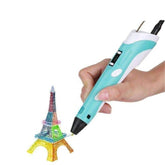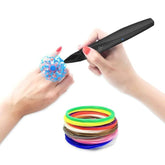How To Use a 3D Pen
Summary
Are you interested in getting creative with technology? 3D Printing Pens are a great way to do just that. This versatile and easy-to-use tool can be used for everything from drawing basic shapes and figures to advanced creations like sculptures and jewelry. In this blog post, we're going to explore what exactly these pens are, how they work, as well as how you can get started using them so you too can start creating your own unique designs!
What is a 3D Pen?
A 3D pen is a tiny tool for children to doodle and sketch in 3D. It is in the form of a pen that extrudes plastic through a nozzle at the tip after pushing plastic through a heated system to melt it. The plastic can be used to create simple or intricate forms and models since it hardens virtually instantaneously. PLA, ABS, Nylon, Wood, and even flexible materials can be used.

A 3D pen is an amazing tool that can be used to create any kind of drawing that comes to mind in a 3D view. Anyone can use this 3D pen without knowing the working principle. The heating element and nozzle are the same as those found in desktop 3D printers. The printer head is guided manually as opposed to being managed by computer software and motors but in the 3D pen we have to draw or sketch the diagram manually similar to using the normal pen. Some electrical and electronic components are used, let us discuss what are the components.
Components of the 3D Pen

- Hot End
- DC Geared Motor
- Motherboard
- Arduino Controller Board
- Transistor (NPN)
- LED Display
How does a 3D Pen Work?
Hot End or Heated nozzles:

The term "hot end" refers to the heater's pointed end or nozzle. The working temperature ranges from 130 to 200 °C thanks to the heat-resistant nonmetal composition. The hot end is another name for it. The filament melts at this temperature and emerges from the nozzle, producing a thin plastic line.
DC Geared Motor
A small-sized DC geared motor with a high starting torque and low revolutions per minute(rpm). Used to push up the filament to the heater when the button is pressed.

Motherboard
It holds together numerous essential parts of a computer, including the memory, connectors for input and output devices, and the central processor unit (CPU). This sheet is printed with the circuit's trace in thin layers of copper or aluminium foil. These traces, which connect the various components, are incredibly narrow. A motherboard includes slots and sockets in addition to circuits for connecting other components. It enables the communication between external peripherals and the system's electronic components. The motherboard has been assembled with the hot end and DC motor.

Controller
A controller is used to control the hot end and DC motor speed as per the requirement.
Transistor (NPN)
A bipolar transistor called an NPN has a P-doped semiconductor layer (the base) between two N-doped layers. Large collector and emitter currents are created from a small base current by amplifying it. Through the use of digital signals, this NPN transistor serves as a switch to maintain the setup's ON or OFF state.
LED Display
A single LED Display has been connected to the controller board to display the operation and temperature settings.
Choosing the Correct 3D Pen and Filament
There are so many different types of designing pens available in the market. Choosing the right pen according to your requirement could be challenging, some of the points are given below to help you with choosing the right 3D pen,
Comfortable to Hold
Holding the object should be comfortable because 3D drawing tasks typically take a long time. Even though one of our experts claimed that any 3D pen's shape could be used, we selected a pen with a more anatomical shape that is pleasant right away.
Consistent Plastic Extrusion
To increase your sense of control over the pen, the pen may vibrate continuously while you insert the filament into it.
Customized Settings
Settings that can be changed include the ability to work with a larger variety of filament types and the ability to switch speeds slower or faster.
Safe
The pen shouldn't emit any hazardous or offensive odors.
Selection of Filament for 3D Pen
The motors in 3Doodler's pens are made to handle straight, short strands of plastic rather than the longer, coiled strands typical of cheap third-party filament. So far, the majority of filaments are made of polylactic acid (PLA) and acrylonitrile butadiene styrene (ABS) also nylon and wood-type filaments. The majority of entry-level 3D pens are made specifically to use these filaments.
How to Prepare your 3D Pen for Printing
Step 1: Power up the module through a power jack.
Step 2: Insert the plastic filament.
Step 3: Change the speed of the motor using the load filament buttons
Step 4: An indicator light is blinked to indicate the filament is heating.
Step 5: Wait for a minute to warm the filament after that again press the load filament the filament is melted and comes out of the nozzle.
Step 6: Draw the 3D of your wish.
Step 7: Press the unload button after completing the drawing.
What can you create with a 3D Pen?
A 3D pen works on any flat surface for drawing. The actual appeal of a 3D pen, however, is in its ability to write three-dimensional objects in midair using plastic filament before they solidify. Alternatively, you may add details by drawing on an already existing object. By "welding" the pieces back together with melted ABS using a 3D pen, you might even be able to fix shattered ABS plastic objects.
- Basic 3D models and shapes.
- Jewellery, hanging ornaments, and pendants.
- Decorative art.
- In the realm of architecture, it is used to provide the first renderings of the project.
- It is employed to reconnect broken objects and restore broken ones.
Conclusion:
In this blog post, we have learned that a 3D pen is a versatile tool that allows you to bring your creative ideas to life in 3D Understanding its components, how it works and choosing the right pen and filament are key to getting the most out of your 3D printing experience. Whether you are a beginner or an experienced user, preparing your 3D pen for printing is simple and straightforward. The possibilities of what you can create with a 3D pen are endless, from 3D sketches and models to intricate sculptures and jewelry. Unleash your creativity and start exploring the world of 3D printing today!
If you appreciate our work don't forget to share this post and leave your opinion in the comment box.
Please do check out other blog posts about Popular electronics
Make sure you check out our wide range of products and collections (we offer some exciting deals!)








